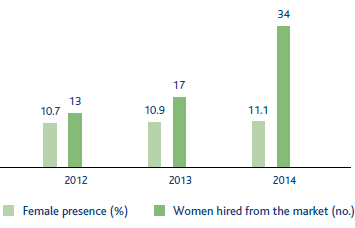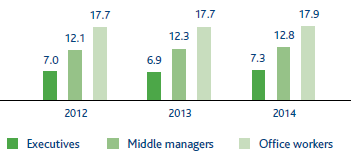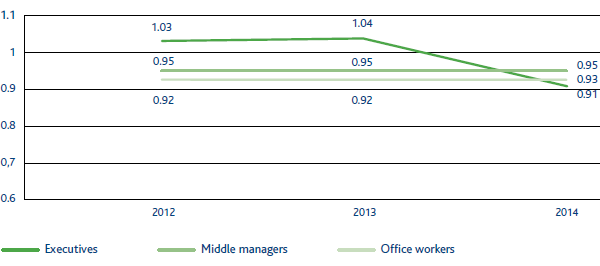Diversity and equal opportunities GRI - G4: LA3, LA12
Snam respects everyone’s dignity and offers equal opportunities in all phases and all aspects of employment, including selection, hiring, training, compensation, promotion, transfers and termination of employment, avoiding any form of discrimination that may arise from differences in gender, age, state of health, nationality or political or religious opinions.
The average age of the Group’s employees has dropped compared to previous years from just over 49 to a little less than 48; at the same time, average time in service is about 24 years, which is unchanged from the previous year.
Despite the typical characteristics of the business activity, which require specific technical training that mainly involves men in the marketplace, the female component is rising. In 2014, about 18% of new hires were women.
Women now represent 11.1% of the company’s entire workforce. In 2014, the percentages of the workforce concerned by category were as follows: 7.3% of executives and 12.8% of managers were made up of women.
The analyses carried out on the company’s workforce involved in the Leadership Development programme showed that the presence of women in senior positions is bound to grow. At present, in such positions, the ratio of women to men is 13%, but this ratio is 33.3% among managers participating in the programme, and 38.8% among high flyer employees.
In addition to the analysis was the appointment in July 2014 of 4 new executives of the Group, 50% of whom were women.
An average of 17.4 training hours per employee were provided during the year to women, which is lower than last year, which was affected by a high percentage of training hours provided to manual labourers (47% in 2014), among whom there are practically no women.
| Download XLS (22 kB) |
|
STAFF TRAINING BY GENDER (no.) GRI – G4: LA9 |
|||
|
|
|
|
|
|
|
2012 |
2013 |
2014 |
|
Average training hours delivered to men (hours/year) |
28.1 |
32.7 |
30.2 |
|
Average training hours delivered to women (hours/year) |
13.6 |
33.6 |
17.4 |
The Group employs 311 people with disabilities, whose development programmes focus on training and integration into corporate processes. There is not a significant presence of ethnic and linguistic minorities in our workforce, partly due to the fact that Snam operates only in Italy.
STATISTICAL DIVERSITY: EMPLOYEES BY AGE GROUP (no.)

FEMALE PRESENCE

FEMALE PRESENCE BY POSITION (%)

FEMALE/MALE PAY DIFFERENTIAL

In 2014, the pay gap between female/men managers decreased following the hiring of two new senior female roles.
With regard to maternity, personnel benefit from more favourable provisions than those required by law, while maintaining the corporate benefits provided. During the mandatory leave period, the Company provides maternity pay at 100% of the salary of the month prior to commencement of leave (compared with 80% as required by law).
Over time, Snam has invested in the creation of an entire group of tools designed to provide a better work/life balance for its employees. In addition to the widespread use of part-time work as an incentive system for staff who may require it (in 2014, 93 employees had part-time contracts), Snam has created an ad hoc section of its intranet, dedicated to providing the most extensive news and information possible on welfare initiatives for people working at the Company.
In 2014, 403 people returned to work after parental leave out of 428 positions ended (80 of which were taken by women), while in 2013 these amounted to 437. Snam and the law provide opportunities for hours/periods away from work, depending on the personal situations of employees. The figure shown includes authorisations for family bereavement, serious family problems, breastfeeding, child illness, etc. 60 parental leave positions are open at year-end (15 for women and 45 for men).
Internationalisation of Snam
Snam’s gradual internationalisation led the HR department to cooperate with other companies in the gas sector and promote the diversity of different cultures in Europe. In particular: together with Fluxys, a strategic partner, it analysed and compared corporate processes and operating procedures, and the cultures and procedures of the two companies seeking a synthesis and meeting point between them. Together with TIGF, it shared the HR practices of the two companies. It collaborated with Interconnector UK in the area of support for the strategic project of change required for the English company. It worked with TAG to create and structure a new company certified as ITO. All of this was done to share skills and in the context of respecting cultural diversity.
Snam has a “procedure for the international mobility of its staff”, which is needed to manage the transfers of employees to foreign subsidiaries. Using this tool, and as a result of signing specific agreements with subsidiaries, Snam began sending the first employees abroad to foreign companies in its area: to TIGF to cover the position of Technical General Manager, and to TAG to cover the position of managing director and head of the legal department. In addition, in September Snam received the first employee coming from TIGF, who was employed in the Regulatory Affairs Department.
The Company continued to work with TIGF on the Partage Project, which will be completed at the beginning of 2015. In 2014, over 50 employees from Snam were involved in 15 theme-based work groups.
A total of 26 workers (male and female) took maternity and paternity leave in the year (36 in 2013).
A guide has been published on the intranet for both biological and adoptive parents with a view to raising awareness about their rights and highlighting the Company’s dedication to parenting.
